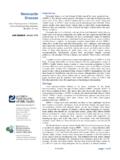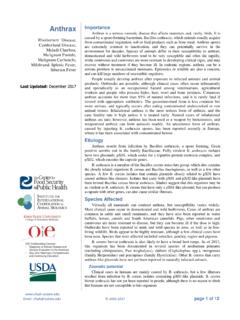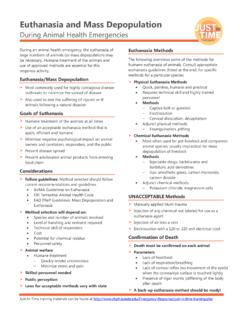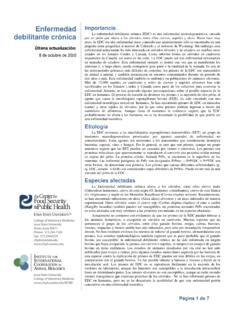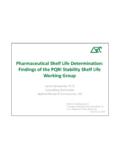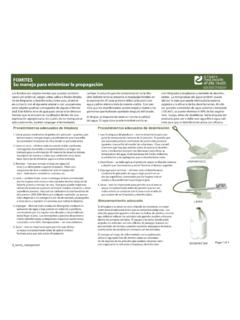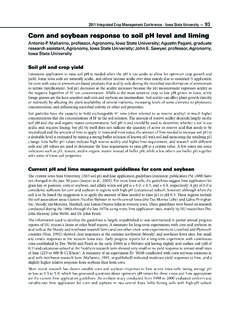Transcription of Brucellosis: Brucella canis - Iowa State University
1 Brucellosis: Importance Brucellosis is a zoonotic bacterial disease caused by several species in the genus Brucella canis Brucella . Brucella canis is an important cause of reproductive failure in dogs, especially in kennels. Infections can result in abortions and stillbirths in bitches, and epididymitis, prostatitis, orchitis and sperm abnormalities in males. Although spayed Contagious Abortion, or neutered dogs do not have reproductive signs, they occasionally develop other Undulant Fever conditions such as ocular disease and discospondylitis. B. canis may persist in an animal even after antibiotic treatment.
2 In kennels, infected dogs are often euthanized to prevent them from infecting other dogs or people. Canine brucellosis is sometimes Last Updated: May 2018. difficult to diagnose with the currently available tests. The importance of B. canis as a cause of human illness is still unclear. Few clinical cases have been reported in people, and most have been mild. However, human infections with this organism may be underdiagnosed, as the symptoms are nonspecific, diagnostic suspicion among physicians is low, and obtaining a definitive diagnosis may be difficult. Etiology In dogs, brucellosis is mainly caused by Brucella canis , a Gram-negative coccobacillus in the family Brucellaceae (class Alphaproteobacteria).
3 Other Brucella species occasionally associated with disease in dogs include B. abortus, B. melitensis and B. suis. More information on the latter organisms is available in the respective factsheets at Taxonomy note: At one time, the genus Brucella was reclassified into a single species, B. melitensis, based on the genetic and immunological evidence that all members of this genus are closely related. Under this system, the various species of Brucella were considered to be biovars. This proposal was controversial, and has fallen out of favor for practical reasons. Species Affected Dogs are thought to be the only significant hosts for B.
4 canis among domesticated animals. Antibodies to this organism have been detected in cats in South America, but bacteria were not recovered. After oral inoculation, 3 of 14. experimentally infected cats developed bacteremia, and agglutinating antibodies were not detected. Antibodies to B canis have also been reported occasionally in wild canids including foxes, coyotes ( canis latrans) and golden jackals ( canis aureus), a wild raccoon (Procyon lotor), and diverse captive carnivores including hoary foxes (Lycalopex vetulus), little spotted cats (Leopardus tigrinus), tayras (Eira barbara) and possibly coatis (Nasua nasua).
5 B. canis nucleic acids have been found in captive pumas (Puma concolor), ocelots (Leopardus pardalis, and a jaguar (Panthera onca). Experimental infections have been established in nonhuman primates, laboratory rodents (mice, guinea pigs) and rabbits. Sheep, swine and cattle were found to be highly resistant to infection by oral and conjunctival inoculation; however, rare field infections with B. canis have been reported in cattle. Zoonotic potential B. canis is zoonotic, but relatively few cases have been reported to date. One clinical case was caused by the M- strain of B. canis , a laboratory strain that has reduced virulence and is used as an antigen for serological testing.)
6 Geographic Distribution B. canis appears to be widely distributed, and has been reported in North, Central and South America, and parts of Asia, Africa and Europe. New Zealand and Australia appear to be free of B. canis ; however, Australia has reported some B. suis infections in dogs, mainly in animals used to hunt feral pigs. Transmission B. canis occurs in birth products ( , the fetus, placenta, fetal fluids) and vaginal discharges from an infected bitch, and can persist in vaginal discharges for several weeks. It can also be shed in normal vaginal secretions, particularly during estrus, and in milk.
7 In males, semen can contain high concentrations of B. canis for weeks or Email: 2007-2018 page 1 of 10. Canine Brucellosis months after infection, and intermittent shedding of smaller Disinfection quantities may persist for years. This organism is also shed Brucella spp. are readily killed by most commonly in urine, and low concentrations of bacteria have been available disinfectants including hypochlorite solutions, detected in saliva, nasal and ocular secretions, and feces. 70% ethanol, isopropanol, iodophors, phenolic In dogs, B. canis primarily enters the body by ingestion disinfectants, formaldehyde, glutaraldehyde and xylene.
8 A. and through the genital, oronasal and conjunctival mucosa, 1% solution of citric acid was reported to be less effective. but transmission through broken skin may also be possible. Brucellae are inactivated fairly quickly by acid pH < Most cases are thought to be acquired venereally (including They can also be destroyed by moist heat of 121 C (250 F). via artificial insemination) or by contact with the fetus and for at least 15 minutes, dry heat of 320-338 F (160-170 C). fetal membranes after abortions and stillbirths. However, for at least 1 hour, or gamma irradiation. Boiling for 10.
9 This organism may also be transmitted between dogs during minutes is usually effective for liquids. close contact, even in the absence of mating or pregnancy. In one study, uninfected, intact male or female dogs Infections in Animals acquired B. canis within 6 months when they lived with infected, intact animals of the same sex under laboratory Incubation Period conditions. Sexually immature, intact dogs did not readily The period between infection and reproductive losses is transmit this organism to each other under the same variable. Abortions are most common during the last conditions.
10 Puppies can be infected in utero, and may trimester of gestation, and early embryonic deaths have remain persistently infected even if they appear normal. been seen a few weeks after venereal transmission. The Puppies can also be infected from milk, but the importance incubation period for epididymitis is reported to be 5 weeks of this route is controversial. Potential iatrogenic sources of or more in most cases. infection include blood transfusions and contaminated syringes. There is no evidence that arthropods play any role Clinical Signs in the epidemiology of brucellosis; however, some species B.

